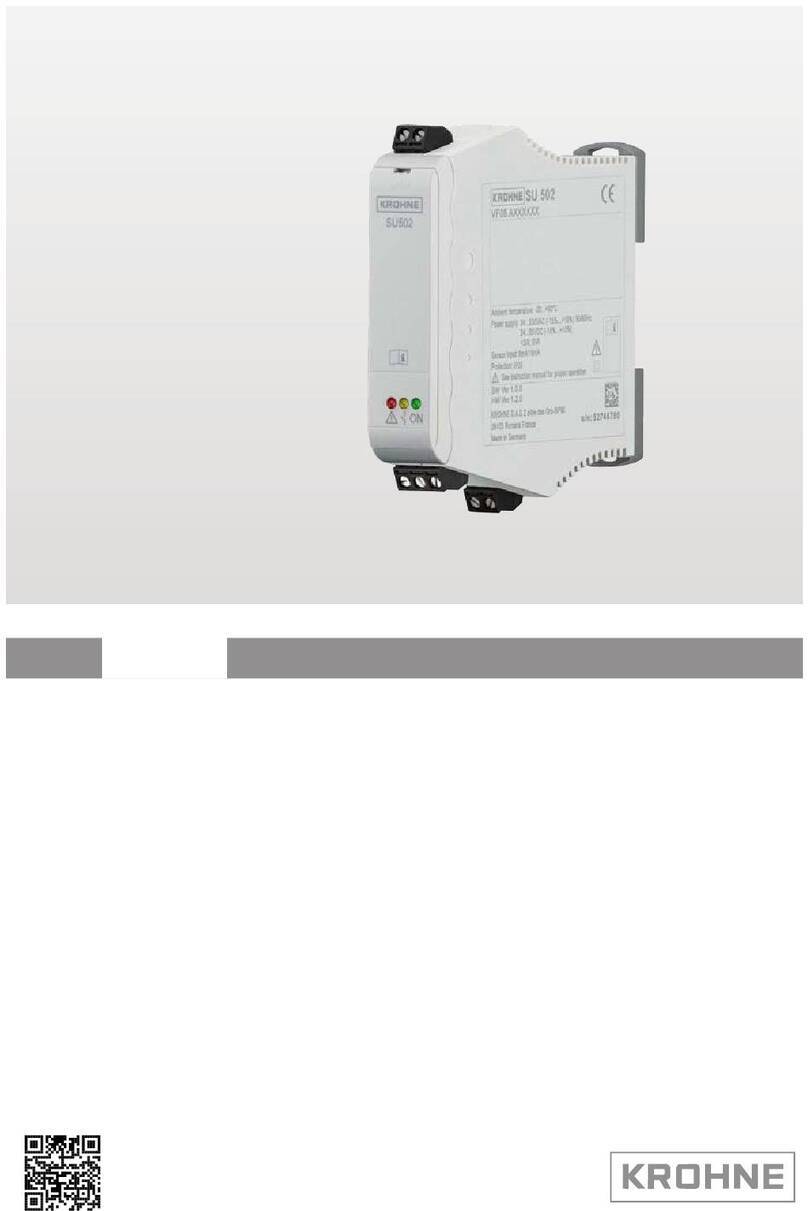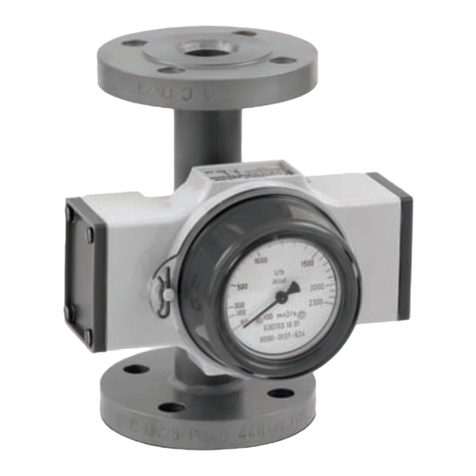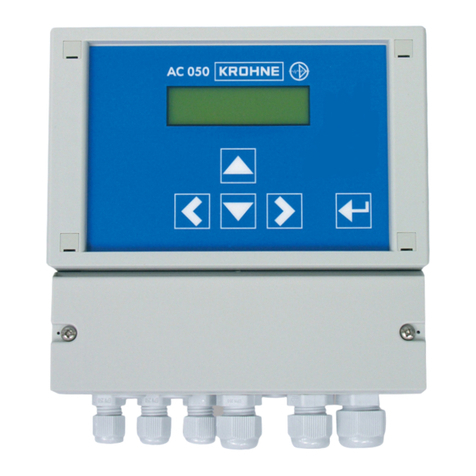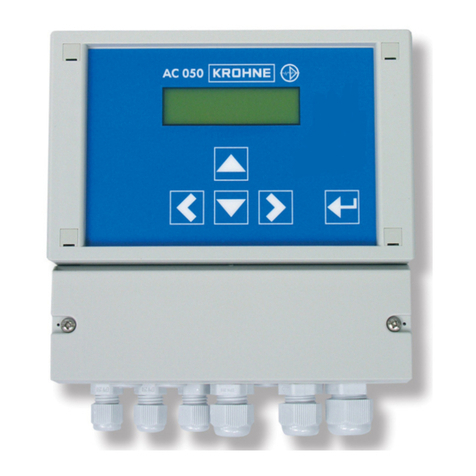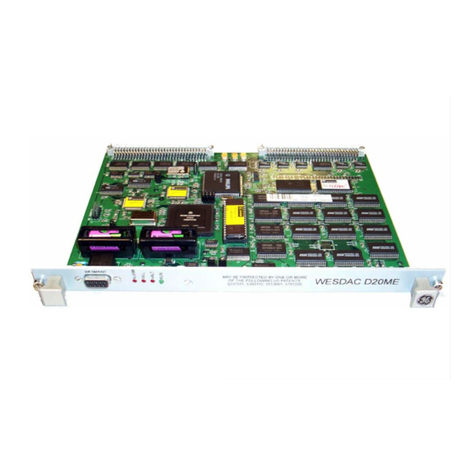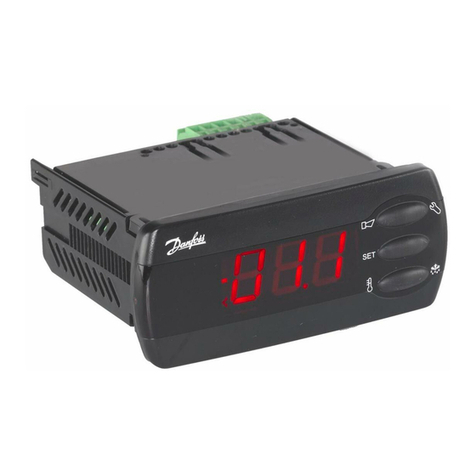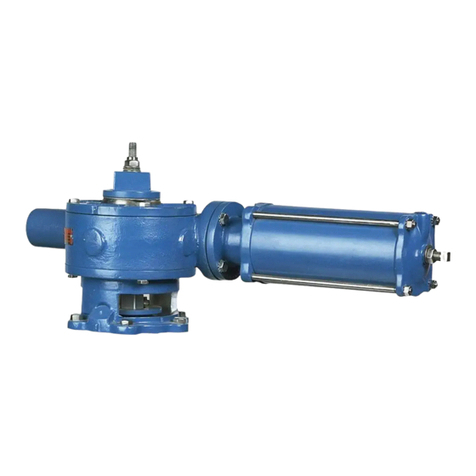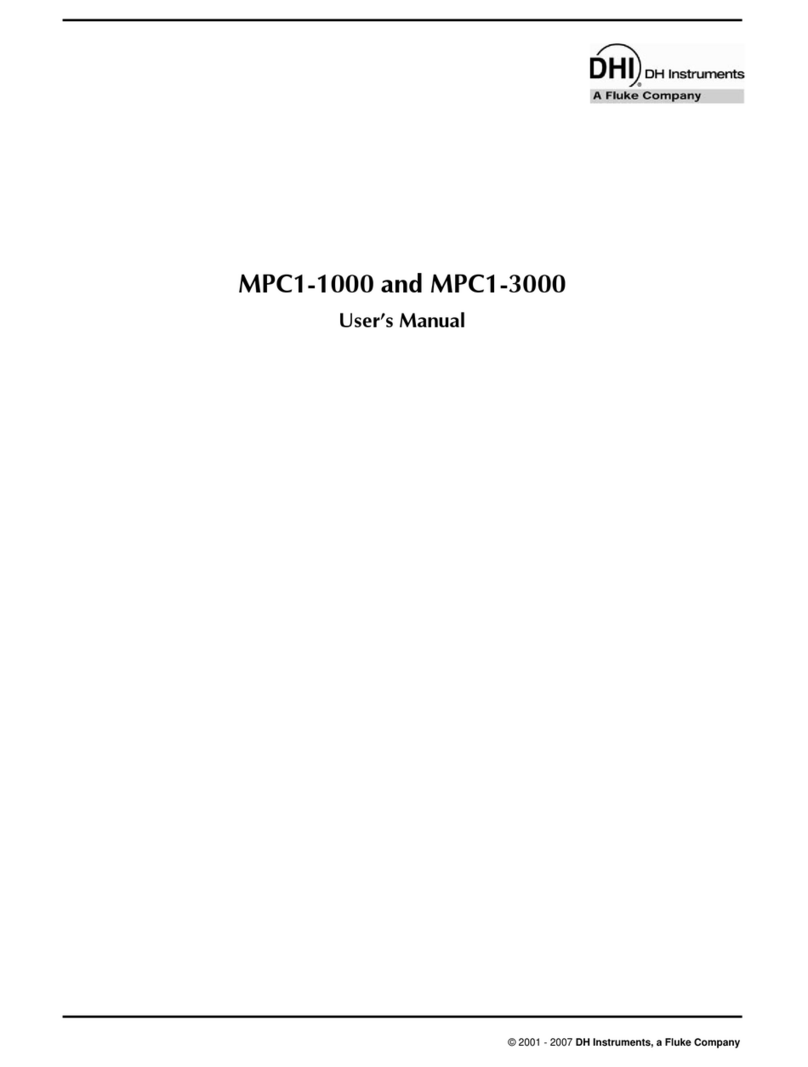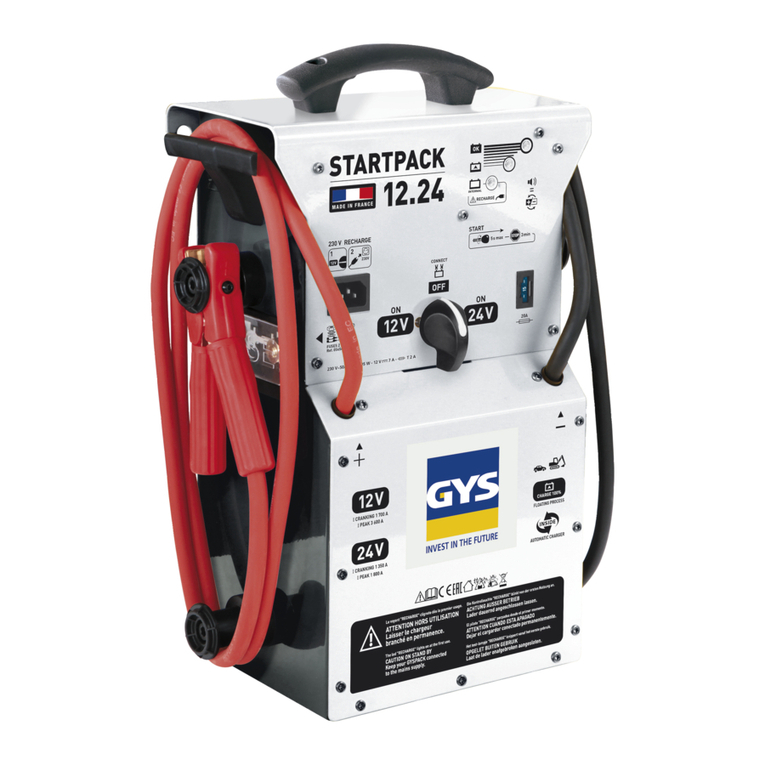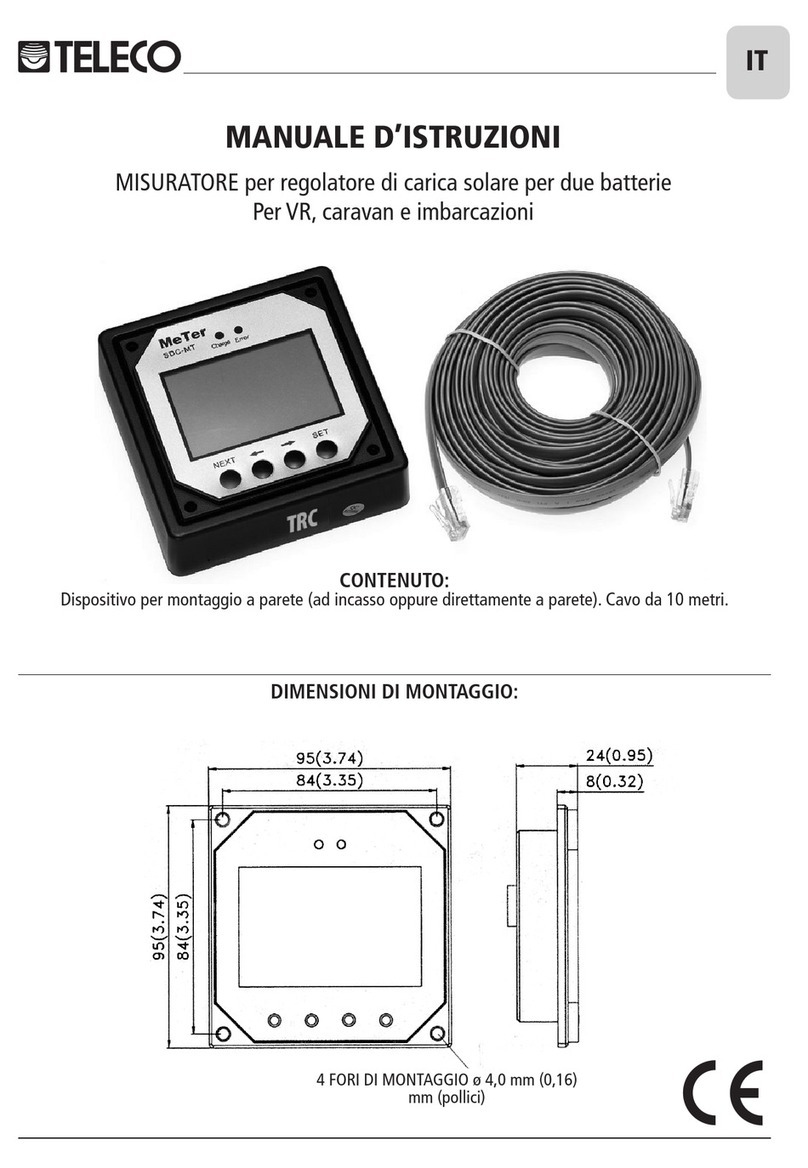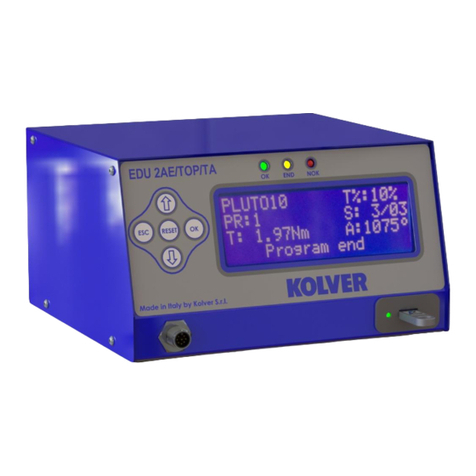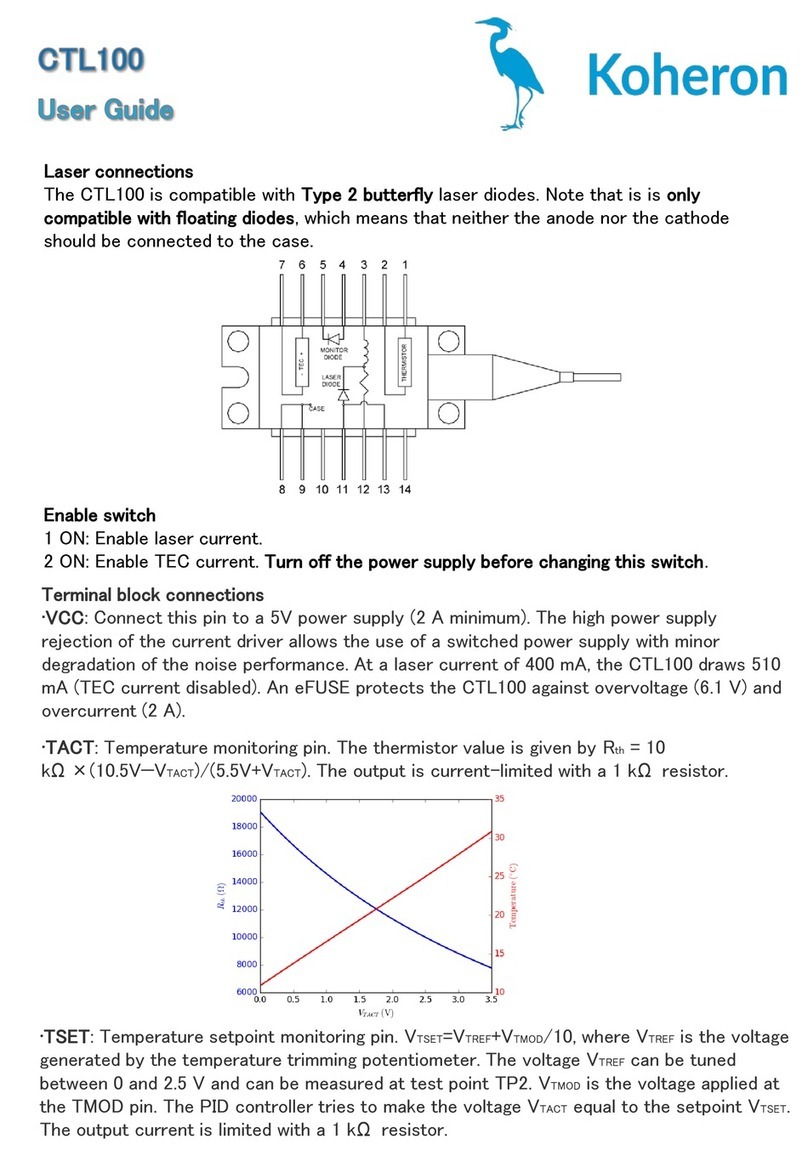KROHNE OPTISENS PAC 050 User manual

07/2008 Installation and
Operating Instructions
OPTISENS
PAC 050
Measuring and control device
for pH and ORP measurements

Manual OPTISENS PAC 050
OPTISENS PAC 050 2
Content
0. Introduction.........................................................................................................................................................................................4
0.1 General .................................................................................................................................................................................................................. 4
0.2 Legal matters......................................................................................................................................................................................................... 4
0.3 Safety..................................................................................................................................................................................................................... 5
0.3.1 Documentation symbols......................................................................................................................................................................................... 5
0.4 Features................................................................................................................................................................................................................. 6
0.4.1 Device.................................................................................................................................................................................................................... 6
0.4.2 Controller................................................................................................................................................................................................................ 6
0.4.3 Connections........................................................................................................................................................................................................... 6
1. Mechanical installation......................................................................................................................................................................7
1.1 Installation of panel-mounting converters.............................................................................................................................................................. 7
1.2 Installation of wall-mounting converters................................................................................................................................................................. 8
2. Electrical connection..........................................................................................................................................................................9
2.1 Connection diagram panel-mounting converter................................................................................................................................................... 10
2.2 Connection diagram wall-mounting enclosure..................................................................................................................................................... 11
3. Operation of the device....................................................................................................................................................................12
3.1 How to adjust parameters.................................................................................................................................................................................... 12
3.1.1 Selection between alternatives............................................................................................................................................................................ 12
3.1.2 Adjustment of numerical parameters................................................................................................................................................................... 13
3.2 Menu Overview.................................................................................................................................................................................................... 13
3.2.1 Main menu and basic settings............................................................................................................................................................................. 13
3.3 Password and language ...................................................................................................................................................................................... 14
3.3.1 Enter password.................................................................................................................................................................................................... 14
3.3.2 Language............................................................................................................................................................................................................. 14
4. Adjustments for the measurement.................................................................................................................................................14
4.1.1 Measurement....................................................................................................................................................................................................... 15
4.2 pH measurement.................................................................................................................................................................................................. 15
4.3 ORP measurement.............................................................................................................................................................................................. 15
4.4 Calibration............................................................................................................................................................................................................ 16
4.4.1 Calibration procedure........................................................................................................................................................................................... 16
4.4.2 Buffers.................................................................................................................................................................................................................. 16
4.5 Temperature compensation................................................................................................................................................................................. 17
4.5.1 Calibration of the temperature measurement ...................................................................................................................................................... 17
5. Adjustments of the controller..........................................................................................................................................................17
5.1 ON/OFF controller................................................................................................................................................................................................ 18
5.2 P / PI controller as impulse-frequency controller................................................................................................................................................. 19
5.3 P / PI controller as pulse-pause controller........................................................................................................................................................... 19
5.4 Activation and deactivation of the controller........................................................................................................................................................ 20
5.5 Turn-on delay....................................................................................................................................................................................................... 20
5.6 External controller stop........................................................................................................................................................................................ 20
5.7 Manual operation of the relays............................................................................................................................................................................. 21
5.8 Limit values.......................................................................................................................................................................................................... 22
5.8.1 Turn-on delay....................................................................................................................................................................................................... 22
5.9 Dosage check ...................................................................................................................................................................................................... 22
6. Alarm..................................................................................................................................................................................................23
6.1 Error messages.................................................................................................................................................................................................... 24
7. Output................................................................................................................................................................................................24
7.1 Current output...................................................................................................................................................................................................... 25
7.2 Serial interface RS485 (option)............................................................................................................................................................................ 25
8. Operation and maintenance............................................................................................................................................................25
8.1 Maintenance of the device................................................................................................................................................................................... 25
8.2 Display contrast.................................................................................................................................................................................................... 25
8.3 Exchange fuse..................................................................................................................................................................................................... 25
8.4 Cleaning............................................................................................................................................................................................................... 25
8.5 Maintenance of the pH or ORP measurement..................................................................................................................................................... 26
8.6 Disposal ............................................................................................................................................................................................................... 26
8.7 Service................................................................................................................................................................................................................. 26
8.7.1 Product info.......................................................................................................................................................................................................... 26
8.7.2 Analog inputs ....................................................................................................................................................................................................... 26
8.7.3 Erase settings (reset)........................................................................................................................................................................................... 26

Manual OPTISENS PAC 050
3 OPTISENS PAC 050
9. Technical data...................................................................................................................................................................................27
9.1 Technical data...................................................................................................................................................................................................... 27
9.2 Dimensions .......................................................................................................................................................................................................... 28
9.2.1 Panel-mounting enclosure................................................................................................................................................................................... 28
9.2.2 Wall-mounting enclosure ..................................................................................................................................................................................... 28
10. Device return form............................................................................................................................................................................29
11. Customer settings - for reference...................................................................................................................................................30

Manual OPTISENS PAC 050
OPTISENS PAC 050 4
0. Introduction
0.1 General
This manual applies to the following devices:
Device and type Revision date
AC 050 pH/ORP P 06 / 05
AC 050 pH/ORP W 06 / 05
It contains technical information for the installation, start-up and maintenance. If you have any questions not
included in this manual please contact your supplier or the official representative of KROHNE Water Solutions
in your country.
0.2 Legal matters
Authorized personnel
Installation, connection, adjustment, start-up, and maintenance of the device are carried out by authorized
personnel with adequate qualification.
Liability
Responsibility as to suitability and intended use of these devices rests solely with the user. Improper
installation and operation may lead to loss of warranty. In addition, KROHNE Group's Standard General
Conditions of Sale and Delivery, found on the back of the invoice and forming the basis of the purchasing
contract, are applicable.
General limitation on liability
Unless otherwise expressly set forth in the Standard Terms and Conditions of Sale and Delivery, the Seller is
only liable for damages, whatever their legal basis is, in case they are based on willful action or gross
negligence. This limitation on liability does not apply in the event the Buyer raises claims relating to personal
injury or damages to property according to the product liability law based on a defect of the delivered goods.
Any advice given by the Seller, in particular regarding the application of the delivered goods, shall only commit
the Seller if given or confirmed in writing.
Returning the device
If you need to return the level gauge to the manufacturer or supplier, please read to the instructions and
complete the form given in the appendix.
Warranty
Please consult KROHNE Water Solutions General Terms and Conditions for information on guarantee and
liability.

Manual OPTISENS PAC 050
5 OPTISENS PAC 050
0.3 Safety
Please check for damages immediately after receiving the devices and report any damages within 24 hours to
the delivering company. Never work with a damaged device.
Keep this manual at a safe place where you can always look up the safety instructions and the information on
handling and usage.
This device was designed and built according to the safety measurements for electronic devices and has left
our company in perfect working condition. To preserve this condition and to ensure safe usage follow all
instructions carefully and pay special attention to all warnings issued in this manual. If the device is visibly
damaged or has been stored inappropriately or if there are any doubts concerning safe usage, shut it down
and make sure it cannot be restarted by accident.
0.3.1 Documentation symbols
A set of symbols is used to give warnings or information relevant to particular applications. These are defined
below:
Caution / Attention
Information that, if not followed, may lead to actions resulting in incorrect functioning of the device.
Warning
Information that, if not followed, may lead to actions resulting in measurement error, personal injury and/or
damage to the device.
NOTE
Is used to highlight interesting details.

Manual OPTISENS PAC 050
OPTISENS PAC 050 6
0.4 Features
0.4.1 Device
0.00…14.00 pH
Measuring ranges
-1500…+1500 mV
Temperature measuring ranges -30.0…+140.0°C
Display measured value with dimension
temperature with dimension
status display sensor, calibration, controller & alarm
Temperature compensation manually or automatically with Pt100 or Pt1000
Calibration automatic recognition of the calibration solutions in arbitrary order
0.4.2 Controller
Set points 2 set points with adjustable direction
Controller types ON/OFF controller with hysteresis
P controller as Pulse-Pause-, Impulse-Frequency- or steady controller
PI controller as Pulse-Pause-, Impulse-Frequency- or steady controller
Hysteresis 0.00…14.00 pH or 0…1500 mV
P range XP0.00…14.00 pH or 0…1500 mV
Integral time TN0…2000 s
Least pulse 0.1…9.9 s
Pulse+ pause time 02…99 s
Impulse frequency 00…72 equiv. to 0...7200 pulses/h
Turn-on delay 0…200 s
Alarm function min. and max. limit and onset delay, power failure alarm,
impulse or permanent signal
Dosage control 0…2000 s
0.4.3 Connections
Relays 3 potential-free contacts (2x controller, 1x alarm)
6 A, 250 V, max. 550 VA
Analog output 0/4…20 mA galvanically isolated
max. burden 500 Ohm
Analog inputs 1 measuring input for pH or ORP
1 measuring input for Pt100 or Pt1000
Digital input external controller stop or lack-of-water indication
Serial interface (Option) RS 485, Baud rate 9600, data format 8 Bit,
1 start and 1 stop bit, no parity

Manual OPTISENS PAC 050
7 OPTISENS PAC 050
1. Mechanical installation
On chapter 9.2 you will find detailed instructions for the installation.
For panel-type meters you have to prepare an opening of 92 x 92 mm / 3.6” x 3.6”. Install the device and fix it
with the two mounting clips which were part of the delivery.
You can install devices in wall-mounting enclosures either by hanging them upon the center slot or by sliding
the slot under a screw, which is an alternative for limited space. Either way you have to fix it additionally with
two screws.
ATTENTION
Install the device in a place where it is not put under mechanical or chemical strain!
Mind the protection class:
•Panel mounting version: IP 54 (front), IP 30 (Housing)
•Wall mounting version: IP 65 (closed terminal cover)
1.1 Installation of panel-mounting converters
Prepare an opening of 92 x 92 mm / 3.6” x 3.6”.
Install the device from the front side and fix it with the
two mounting clips which were part of the delivery.
Screw tight until the device is fixed perfectly.

Manual OPTISENS PAC 050
OPTISENS PAC 050 8
1.2 Installation of wall-mounting converters
Unscrew the terminal cover.
Drill three holes (max. M5) according to the drawing.
Mind that there are two ways for installation:
(1) You can hang the device upon the upper screw.
In that case drill the upper hole 120mm / 4.7” above
the lower two.
(2) Or you can slip the fixture on the back of the
device under the upper screw. In that case the upper
hole has to be another 15mm / 0.6” higher.
Insert the upper screw and make sure to leave at
least 3 mm between wall and screw head for the
fixture.
Mount the device and fix it with the two lower
screws. Close the terminal cover or start with the
connections.

Manual OPTISENS PAC 050
9 OPTISENS PAC 050
2. Electrical connection
You will find a detailed connection diagram on the following pages.
Before connecting the power supply check the information on the nameplate of the device!
ATTENTION
Input, output and control lines must be installed separate from each other and separate from power lines!
For inputs and outputs use screened lines and connect the screen on one side only.
The pH measurement is interference-sensitive. Use a special screened cable and over long distances or in
humid atmosphere additionally an impedance converter.
When using the relays, mind that with inductive loads, interference must be suppressed. If that is not
possible, the relay must be protected at the terminal block in the converter by a resistance-capacitance filter
or, in case of direct current, by a free- wheeling diode.
Current up to Capacitor C Resistance R
60 mA 10 nF 260 V 390 Ohm 2 Watt
70 mA 47 nF 260 V 22 Ohm 2 Watt
150 mA 100 nF 260 V 47 Ohm 2 Watt
1.0 A 220 nF 260 V 47 Ohm 2 Watt

Manual OPTISENS PAC 050
OPTISENS PAC 050 10
2.1 Connection diagram panel-mounting converter
Connection Terminals Notes
1 = reference electrode = screenpH electrode 1 - 2 2 = measuring electrode = core
1 = measuring electrode = coreORP electrode 1 - 2 2 = reference electrode = screen
Measurement = brown & white
1 = brown, 2 = white
Supplied voltage = yellow & green
Impedance converter
1 - 4
3 = yellow = -6V, 4 = green = +6V
Pt 100 5 + 6
Analog output 9 + 10 9 = +, 10 = - max. burden 500 Ohm
Digital input 11 + 12 11 = +, 12 = - External controller stop or lack of water ind.
Relay 1 14 + 15
Relay 2 16 + 17
Relay 3 18 + 19 Alarm relay
Power supply 21+ 22+23 check information given on instrument label
RS485 (option) Sub-D
Sub-D 4/7 3 = +, 8 = -
bridged = terminating impedance activated

Manual OPTISENS PAC 050
11 OPTISENS PAC 050
2.2 Connection diagram wall-mounting enclosure
Connection Terminals Notes
1 = reference electrode = screenpH electrode 1 - 2 2 = measuring electrode = core
1 = measuring electrode = coreORP electrode 1 - 2 2 = reference electrode = screen
Measurement = brown & white
1 = brown, 2 = white
Supplied voltage, yellow & green
Impedance converter 1 - 4
3 = yellow = -6V, 4 = green = +6V
Pt 100 6 - 7
Display contrast Display Potentiometer to adjust the display contrast
Analog output 11 + 12 11 = +, 12 = - max. burden 500 Ohm
Relay 1 14 + 15
Relay 2 16 + 17
Relay 3 18 + 19 Alarm relay
Power supply 20+21+22 check information given on instrument label
RS 485 (option) 23 + 24 23 = 1, 24 = +
Digital input 26 + 27 26 = +, 27 = -, external controller stop or lack-of water indication

Manual OPTISENS PAC 050
OPTISENS PAC 050 12
3. Operation of the device
1 Measured value
2 Status relay 1
3 Status relay 2
Frelay OFF
Jrelay ON
4 Temperature
5 Controller
AUTO: controller ON
MAN : controller OFF
(manual operation of the relays)
6 Orientation aids
7 Key left ()
8 Key up ()
9 Key down ()
10 Key right ()
11 Key “Enter“
When turned on the device shows the measured values of conductivity and temperature together with the
controller mode (Man) and the status of the relays S1 and S2 (both OFF).
With five membrane keys you can move within the menu:
•With key you enter the main menu.
•With keys and you move up and down in the menu.
•With key you address a menu or parameter.
•With key you leave a menu without storing
•With key “Enter“, changes are stored.
For your convenience triangles in the display indicate the directions you can take from your position in the
menu.
3.1 How to adjust parameters
Temp. comp.
Manual. 1) When you address a parameter the actual setting is displayed.
2) Switch to the next alternative setting with key.
Temp. comp.
Auto
Temp. comp.
Manual. 3) When you have come to the last alternative, pressing the key once
more will bring you back to the start.
3.1.1 Selection between alternatives
For many parameters you have the choice between two or more alternatives, for e. g. between manual and
automatic temperature compensation. For these parameters you need only key. Switch from one
alternative to the next until you either come back to where you started or until you reach the alternative you
were looking for.
With these parameters any changes are immediately valid - there is no need to store the change.

Manual OPTISENS PAC 050
13 OPTISENS PAC 050
3.1.2 Adjustment of numerical parameters
Numerical parameters can only be altered when a double arrow is visible behind the number. This double
arrow appears when you address the parameter with key.
Adjust the parameter with keys and . A short pressure on the key changes the last decimal by 1. If you
keep the key pressed, the value will continue changing until the pressure is released.
Store the changes with key „Enter“. The double triangle disappears.
Enter password
058
1) Address the parameter with key .
Enter password
058 2) A double arrow appears behind the number indicating that the number
can be changed now with keys and .
Enter password
062 3) Store the new value with key „Enter“. The double arrow disappears -
the new value is stored.
3.2 Menu Overview
6.98 pH 25.0°C
FS1 FS2 Auto Display of the measured values (example)
Press key to enter the main menu.
Main menu
Calibrate Calibration function (only for pH measurements)
Temp. comp. Temperature compensation (only for pH measurements)
Enter password Password function
Set points Controller settings - set points, P ranges, I functions
Limit values Alarm function
Basic settings
Basic settings Cal. Pt 100
Service Buffers used
Contr. Settings
Turn-on delay
Analog outputs
Language
Bus address
pH/ORP
All parameters which are set just once
at the beginning can be found in the
menu “basic settings“
3.2.1 Main menu and basic settings
The parameters are sorted into two menus: In the main menu you will find all functions which are used
regularly. The menu basic settings contain all parameters which are set just once during start-up.
On the following pages you will find information on how to adjust parameters and which parameters you
need for which application.
The information follows the following scheme:
1) General adjustments: password and language
2) Adjustments for measurement: calibration and temperature compensation for pH or selection of ORP
measurement
3) Adjustments of the controller: selection of the controller version and corresponding parameters
4) Adjustments to read out data: analog, digitally and/or as alarm

Manual OPTISENS PAC 050
OPTISENS PAC 050 14
3.3 Password and language
Main menu
.
.
Enter password Enter password
056 Code
3.3.1 Enter password
To get access to the various parameters you have to enter the correct password:
•Code 11 gives access to the parameters „calibration“, „temperature compensation“, and „set points“.
•Code 86 gives access to all parameters and functions.
With any other number it is impossible to select, view or change any parameter.
Main menu
.
. Basic settings
Basic settings .
. Language
Language
We speak
English
3.3.2 Language
For the communication with the device you can choose from a variety of languages.
Since choosing a language is part of the basic settings, it requires code 86. If a different code is set, you will
be asked to enter the correct password.
4. Adjustments for the measurement
Main menu
Calibrate Calibration of the pH measurement, display of slope and zero-point.
Temp. comp.
.
Selection between automatic and manual temperature compensation,
adjustment of temperature for manual compensation.
.
.
Basic settings
Basic settings Cal. Temp. Calibration of the temperature measurement.
Buffers used
Adjustment of the calibration solutions and the
inner buffer of the electrode.
The instruments can be used for pH or ORP measurements.

Manual OPTISENS PAC 050
15 OPTISENS PAC 050
4.1.1 Measurement
Configuration
pH/Redox
Measurement pH/Redox
Measurement pH/Redox
Measurement
Displayed is always the actual active configuration. With keyyou can switch from pH measurement to ORP
measurement. Press the key again to go back to the original setting.
4.2 pH measurement
pH measurement requires a calibration.
By means of calibration the electrode’s characteristics are determined and stored. The procedure is a
subsequent measurement of two solutions with a known pH. The pH values of the buffers used as calibration
solutions are stored in the menu basic settings.
You have to adjust the calibration data only if you want to use special calibration solutions or electrodes with
a special buffer solution.
The electrode’s slope is influenced by temperature. This influence can be compensated by manual or
automatic compensation. Manual compensation means that the temperature is entered manually. Automatic
compensation requires measuring the temperature with a Pt100 or Pt1000.
4.3 ORP measurement
ORP measurements do not require calibration or temperature compensation. Therefore the parameters
„calibration“ and „temperature compensation“ do not appear in the menu if ORP measurement has been
selected.
NOTE
The ORP measurement needs no calibration and no compensation for temperature effects. Therefore these
parameters do not appear in the menu if ORP measurement is selected.

Manual OPTISENS PAC 050
OPTISENS PAC 050 16
4.4 Calibration Main menu Calibrate
Calibrate Meas. val. 6.99pH
.Cal. press&
.Slope
.058 mV/pH
The calibration solutions stored as „buffers
used“ are recognised automatically. It does
not matter whether you start with buffer 1
or 2.
Sensor zero
001 mV
Basic settings
Basic settings .
Buffers used
Buffers used
Buffer 1
7.00 pH
Buffer 2
4.00 pH
Sensor buffer
7.00 pH
4.4.1 Calibration procedure
1) Switch the controller OFF and select manual temperature compensation. Enter the temperature of the
calibration solutions.
2) Immerse the electrode in one of the calibration solutions. Wait until the measured value is stable, then
calibrate by pressing keys and - while still applying pressure - additionally key .
The pH of the calibration solution is now displayed as measured value.
3) Rinse the electrode and repeat step 2 with the second calibration solution.
4) Check the slope and sensor zero-point, then put the electrode back into the armature. Select automatic
temperature compensation and switch ON the controller.
NOTE The slope should be close to 59 mV/pH, the zero-point close to 0 mV. The slope decreases and the zero
error increases with time. When either value exceeds certain limits, the instrument displays an error message
indicating that the electrode has to be replaced.
4.4.2 Buffers
At works the following buffers are stored:
•Calibration solutions: buffer solutions pH 4 and pH 7
•Inner buffer of the electrode: pH 7
If you want to use other calibration solutions, adjust the values - it does not matter if you start with the higher
or the lower pH.
If you are using electrodes with a special inner buffer, adjust the pH value of the sensor buffer, since this
value is used as zero for the calculation of the measured values. You will find the pH of the sensor buffer
printed on the electrode.

Manual OPTISENS PAC 050
17 OPTISENS PAC 050
4.5 Temperature compensation
Main menu Automatic
compensation Manual
compensation
.Temp. comp. Temp. comp.
Temp. comp. Auto comp. Manual comp.
.Temperature
.25.0°C
.
Basic settings Calibration
temperature
Basic settings Cal. temp. Cal. temp.
0.0°C
Select between two ways of compensation:
1) Automatic compensation with temperature sensor
Mind that the temperature sensor should always measure the medium temperature around the sensor. When
pH sensor and temperature sensor are not immersed in the same solution, better switch to manual
compensation.
2) Manual compensation
If the temperature can be regarded as constant, you can enter the temperature manually instead of
measuring it continuously. The device will then compensate the temperature error of this temperature.
4.5.1 Calibration of the temperature measurement
If you connect the temperature sensor with a twin-core cable, slight deviations might occur between
measured and real temperature. These deviations can be eliminated by calibration.
During start-up, measure the temperature manually and enter a correction term so that the display shows the
exact temperature.
5. Adjustments of the controller
Main menu
.
.Selection of ON/OFF, P or PI controller, adjustment of P ranges and I
Set points functions for 2 set points
.
.
Basic settings
Basic settings .
.
Contr. settings
Adjustment of frequencies and pulse/pause
times, hysteresis, direction of the control
action, delay.
For any type of controller you have to enter one or two set points, and you have to tell the device whether
these set points are reached by increasing or decreasing the measured value.

Manual OPTISENS PAC 050
OPTISENS PAC 050 18
You can choose between three different controller versions:
ON/OFF controller
The ON/OFF controller switches ON if the measured value exceeds the set point and OFF if it drops back
below it or vice versa. Dosage is always carried out with 100% (ON) or 0% (OFF). The parameter for an
ON/OFF controller is the hysteresis.
P controller
The P controller or proportional controller reduces the dosage in the vicinity of the set point proportional to
the control deviation. This is easily achieved if the analog output is used as steady control output. If the
relays are used, the proportional reduction is achieved by either reducing the switch frequency (Impulse-
frequency controller) or reducing the time within a given period of time in which the relay is ON (pulse-pause
controller).
The parameters for a P controller are the P range and the impulse- frequency or the pulse+ pause time and
the minimum pulse.
PI controller
The PI controller is a P controller with an additional I function. Adjustments and parameters are the same as
for a P controller. Additionally the integral action time has to be adjusted which determines the I function.
The I function eliminates the P controller’s disadvantage of a remaining steady-state deviation.
5.1 ON/OFF controller
Main menu
.
.
Set points and
controller version
Set points Set point S1 You can choose different
.7.50 pH controller versions for S1
.P range S1 and S2
.0.20 pH
Integral Time S1
000 sec.
Set point S2
6.50 pH
P range S2 Controller settings
0.20 pH
.
Integral Time S2 .
000 sec. Direction S1
raise
Basic settings Direction S2
Basic settings .Lower
.
Hysteresis
Contr. settings
0.01 pH
For an ON/OFF controller you have to set the following parameters:
1) Set points S1 and S2
Set point S1 refers to relay 1, set point S2 refers to relay 2.
2) P range and integral action time for S1 and S2
For an ON/OFF controller set P range = 0 and integral time = 0.
3) Acting direction for S1 and S2
Select “raise“ if the dosage raises the measured value.
Select “lower“ if the dosage lowers the measured value.
4) Optionally a hysteresis
The hysteresis prevents fast switching in the vicinity of the set point. If hysteresis is activated (by setting a
value > 0) the relay switches only when the set point is exceeded by half the hysteresis.

Manual OPTISENS PAC 050
19 OPTISENS PAC 050
5.2 P / PI controller as impulse-frequency controller
Main menu
.
.
Set points and
controller version
Set points Setpoint S1 You can choose different
.7.50 pH controller versions for S1
.P range S1 and S2
.0.20 pH
Integral time S1
000 sec
Set points S2
6.50 pH
P range S2 Controller settings
0.20 pH Pulse-Freq. S1
Integral Time S2 00*100/4
000 sec. Pulse-Freq. S2
00*100/h
Basic settings Direction S1
Basic settings .
Raise
.Direction S2
Contr. settings
Lower
For an impulse-frequency controller you have to set the following parameters:
1) Set points S1 and S2
S1 refers to relay 1, S2 refers to relay 2.
2) P range and integral action time for S1 and S2
Adjust a P range > 0. For a P controller set integral time = 0, for a PI controller set an integral time > 0.
3) The acting direction for S1 and S2
Select „raise“ if the dosage raises the measured value.
Select „lower“ if the dosage lowers the measured value.
4) Pulse-frequencies for S1 and S2
Enter the maximum pulse-frequency that corresponds to 100% dosage.
5.3 P / PI controller as pulse-pause controller
Main menu
.
.
Set points and
controller versions
Set points Set point S1
You can choose
.7.50 pH Different controller
.P range S1 Controller Settings Versions for S1+S2
.0.20 pH Pulse-Freq. S1
.Integral time S1 00*100/h
000 sec Pulse-Freq. S.2
Set point S2 00*100/h
6.50 pH Direction S1
P range S2 Raise
0.20 pH Direction S2
Integral time S2 Lower
000 sec.
.
.
Basic settings Pulse+Pause The pulse+pause time
Basic settings .10 sec
must be at least twice
.
Least Pulse as long as the least
Contr. settings
0.1 sec pulse time

Manual OPTISENS PAC 050
OPTISENS PAC 050 20
For a pulse-pause controller you have to set the following parameters:
1) Set points S1 and S2
S1 refers to relay 1, S2 refers to relay 2.
2) P range and integral action time
Adjust a P range > 0. For a P controller set integral time = 0, for a PI controller set an integral time > 0.
3) Pulse-frequencies for S1 and S2
Both frequencies must be set to 00, otherwise the controller will act as an impulse-frequency controller.
4) The acting direction for S1 and S2
Select „raise“ if the dosage raises the measured value.
Select „lower“ if the dosage lowers the measured value.
5) Pulse + pause time
Define a period of time during which the relay is proportionally to the control deviation ON (pulse) or OFF
(pause), respectively.
6) Least pulse time
Set a minimum pulse time that the relay has to at least remain open to allow the actuator to react.
5.4 Activation and deactivation of the controller
The controller is activated and deactivated from the main display without any menus. Press keyto switch
from Manual Mode (controller OFF) to Automatic Mode (controller ON) and vice versa. The actual mode is
indicated in the display.
WARNING
Make sure that the controller is deactivated before connecting dosing pumps or other actuators!
Main menu
.
. Basic settings
Basic settings .
.Turn-on delay
Turn-on delay
Turn-on delay
ON
Turn-on delay
180 s
5.5 Turn-on delay
Set a delay time which has to pass before the controller is activated after start-up or power interrupt. This
allows the measurement to settle and prevents inappropriate dosage of chemicals.
5.6 External controller stop
You can activate or deactivate the controller with an external switch by using the digital input. This feature
requires no settings or adjustments. If the digital input is short- circuited, the controller stops, and the
message „external controller stop“ appears in the display.
NOTE This feature can also be used as lack-of water indication. Just connect a level sensor to the digital input.
This manual suits for next models
2
Table of contents
Other KROHNE Controllers manuals
Popular Controllers manuals by other brands
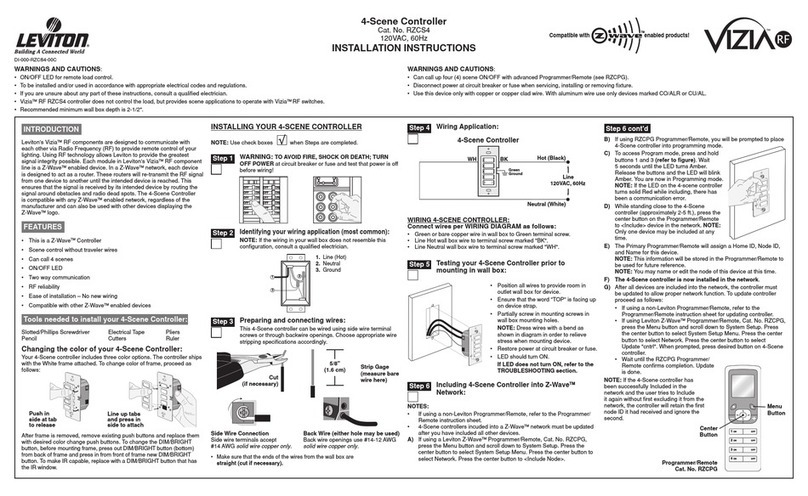
Leviton
Leviton RZCS4 installation instructions
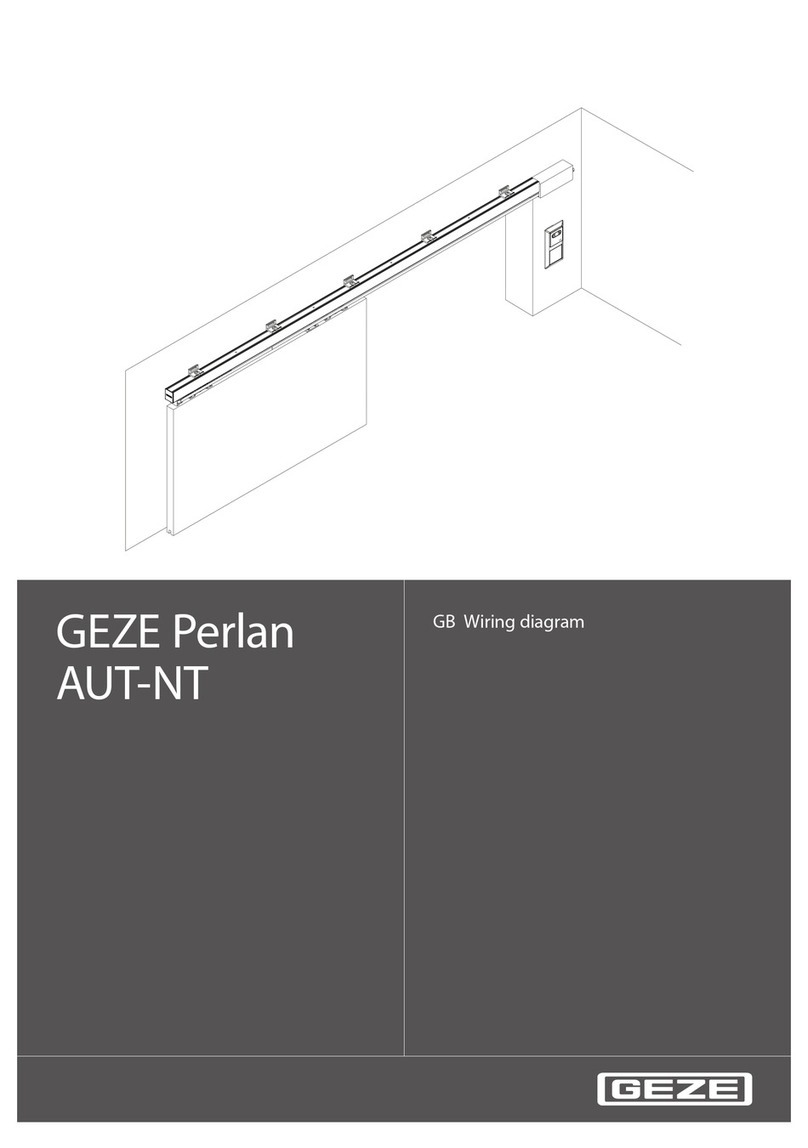
GEZE
GEZE Perlan AUT-NT Wiring diagram
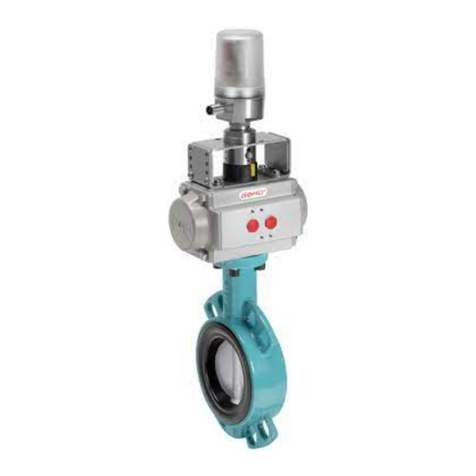
GEM
GEM 1242 Assembly instructions

Mitsubishi Electric
Mitsubishi Electric FX2N-1PG-E installation manual

mecair
mecair MPS Series instruction manual
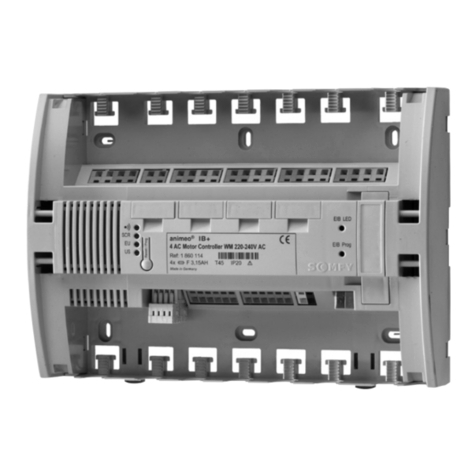
SOMFY
SOMFY animeo IB+ 4 AC Motor Controller WM 100-120 V... installation guide
